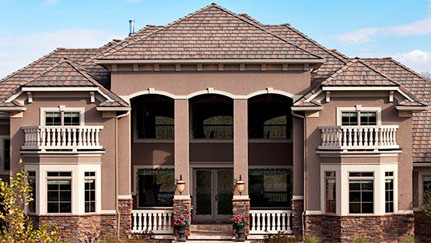
Your roof has a big job to do, as it is a fundamental part of your home. It helps keep you warm in the winter, cool in the summer and dry during rain and snow. It also plays an integral part of keeping unwanted water and moisture out of the structure and helps preserve the integrity of your entire home. In addition, your roof is a crucial component to the appearance and architectural style of your home.
Nationwide Private Client Risk Solutions offers the following tips for some common roof problems and solutions that will help you maintain your roof.
Consider hiring a professional to conduct regular inspections, at least annually. Having your roof cleaned properly is key to maintaining its lifespan.
Inspection/maintenance tips
The following questions can help determine if it’s time for professional maintenance or inspection:
- Are there any interior stains? If yes, we recommend you call someone immediately to prevent further damage and mold.
- When was your last professional roof inspection? If it’s been more than a year, we recommend you consider having someone conduct a thorough inspection.
- Does anything appear abnormal on the roof? Look for irregularities, especially after a weather event, such as high winds, heavy rain or snow.
- Are the shingles, skylights, chimney and boot pipes in good condition? Shingles should not be cracked, missing or curled; skylights should not be cracked, have condensation or damaged flashing; the chimney should not be cracked; and boot pipes, which help prevent water from entering the home, should not be missing or damaged.
- When was the last time the gutters were cleaned? Gutters should be cleaned regularly, as overflowing gutters can cause water to back up into the home and/or cause damage to the roof sheathing, which would lead to rot. Roof rafters are also capable of rotting and growing weaker to exposure of water.
- Is there debris on the roof? Leaves should be removed, especially from roof valleys and areas around chimneys. Failure to do so can cause dams, which will trap moisture and can lead to deterioration and possibly moss growth.
- Is moss present? Moss should be eliminated immediately since it’s notorious for trapping moisture. If the buildup has reached high levels, it can cause shingles to lift, allowing water intrusion into the home.
- Are there any overhanging tree branches? They should be trimmed since they can rub on a roof or fall and damage the roof system, especially during a weather event like high winds or a snow storm. If you live in a wildfire prone area, this is a critical component of creating defensible space around your home.
- If you live in a colder climate, are there any ice dams or snow buildup present? Dams usually form at the roof edges and can make it hard for melting snow to drain from the roof. The water then backs up on the roof and finds its way into the home, causing damage to the interior structure. Have snow cleared off your roof and around your gutters and eaves after a winter storm to help prevent ice dams and/or potential collapse.
Roof replacement time indicators
- How old is the roof? Some common roof coverings like wood or asphalt shingles will last roughly 20-25 years.
- Are you seeing missing shingles, shakes or tiles?
- Are you seeing parts of the roof in your yard or gutter?
- Is there curling, lifting, buckled or broken shingles, shakes or tiles?
- Is tar streaking and/or algae growth visible?
- Can you see daylight through your roof boards (from your attic)?
- Do you have a leaky chimney?
- Are your energy bills higher than usual?
- Are your neighbors replacing their roofs? Homes in the same neighborhood are often built around the same time in suburban areas.
Replacement options
Choose a roof based on your geographic location and exposures such as wind, hail, ultraviolet (UV) rays and moss.
Questions to ask when selecting a roof:
- How long will it last?
- Is the material too heavy for existing roof framing?
- Will it hold up in a natural disaster such as a hurricane or wildfire?
- Do you live in an area of the country where the weather is always sunny? UV rays can cause certain types of roof coverings to deteriorate prematurely and fail.
- Does it complement the style of the home?
- Are the materials eco-friendly or recyclable?
- Is roofing material allowed per your homeowner’s association (HOA) and/or local building codes?
- How much will it cost?
Common roof types, average lifespan and fire and wind resistance
If you have any questions, please contact your agent or Nationwide Private Client Risk Solutions professional. For more information on how you can help prevent losses, visit nationwide.com/solutionseries.
We offer this information to assist you in making decisions that can help mitigate your risk. While we cannot address every possible scenario or guarantee these tips will work for you, our goal is to support your efforts to protect yourself and your family.